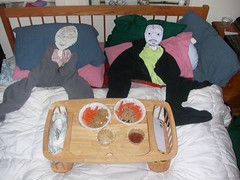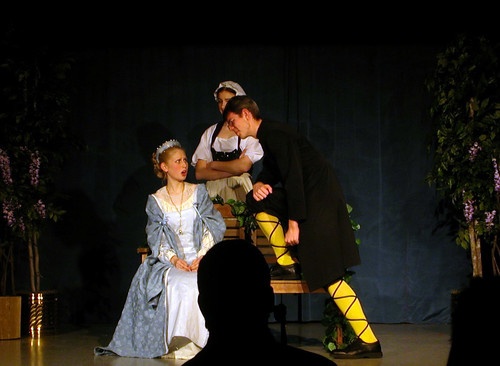I’ve been surveying the usual suspects, web sites that comment on the present unhappy controversies in the Episcopal Church/Anglican Communion. Although I respect and sympathize with Archbishop Rowan Williams, I have the sinking feeling that his hopeful outlook may not be as well-founded as he seems to think.*
I wish I thought we Anglicans could keep together. I will be overjoyed to find that I’m wrong, and I will grieve deeply if “churches will go their different ways, even to the point of competing with one another.” What causes me unease lies in the tone of the observations I find on the various contending sites, and especially on the unwavering confidence the various speakers reflect. I’m especially uneasy when I ask myself, “How would we (or ‘they,’ however ‘we’ and ‘they’ get constructed) know if we (or ‘they’) were wrong?”
For it seems, on the face of things, that of two people saying mutually-contradictory things, one or the other will probably have erred. And if I’m right, if there’s no evident way one or the other party discerning that they might be wrong, how would either recognize their error and seek correction? The disapprobation of the preponderance of Anglican provinces won’t demonstrate that the (majority of the) U.S. church is wrong about sexuality, any more than it demonstrated that the (majority of the) U.S. church was wrong about ordaining women. Since the Windsor Report seems to treat the process leading to the ordination of women (which has become at least a tolerable difference) as exemplary, the U.S. church has some reason to think that its course leading to the consecration of Gene Robinson may mark a parallel path.
But if the (majority of the) U.S. church has gone fatally astray, how are they to know it? One can’t simply repeat that the ordination of non-celibate homosexuals is non-biblical; plenty of what has become common practice was once deemed unbiblical. One can’t invoke the Vincentian canon quod ubique, quod semper, quod ab omnibus creditum est (“that which is believed everywhere, at all times, by all”), not unless one wants to roll back the ordination of women and the possibility of remarriage after divorce (to name but two prominent non-universal points). And even the Windsor Report allows the possibility that the Spirit might effect radical change in the church’s course. That concession obviously doesn’t require that anyone think sexuality constitute such an instance of Spirit-led radical change; at the same time, it evidently holds open the possibility, the mere possibility that the (majority of the) U.S. church’s understanding of sexuality does represent such a surprising change. That being the case, what would count as a reason for the (majority of the) U.S. church to reverse course?
This, I fear, constitutes the inauspicious moment at which the Episcopal Church/Anglican Communion find themselves. On one hand, perhaps the “instruments of unity” can convene a collegium of trusted figures who can conduct deliberations about a way forward without setting any preconditions relative to the outcome. But would the Every Voice Network trust Kendall Harmon even if he were willing to take part in an open-ended conversation? Would the Anglican Mission in America trust me, if I so volunteered? If on a lovely day everyone agreed to trust all who entered the conversation, would that trust survive an outcome that some portion of the Body perceived as inimical to the truth?
In short, can we imagine a way that the various participants in this period of reflection could envision themselves shown wrong? If not, shall we go our separate ways?** Or — to propose a tedious, painful, equivocal, but characteristic alternative — shall we convene a series of meetings, conferences, publications, emendations, synods, commissions, study groups, and task forces until such time as the issue no longer seems as neuralgically sensitive?
* Students in Early Church History — note Abp. Williams’s words:
God became human, said the teachers of the early Church, so that humanity might become ‘divine’ – not by any confusion between God and his creation, but by creation being made into a transparent vehicle of God’s loving purpose and healing action, and most of all by men and women becoming God’s adopted sons and daughters.
Here he alludes to Athanasius, Ad Adelphium 4 and De Incarnatione 54; it’s a very handy thing to know, and it’s vital to bear in mind Abp. Williams’s apposite reservation about not confusing God and created humanity.
** My liturgy professor, the Rt. Rev. Jeffery Rowthorn, used to tell of the first official meeting of an Archbishop of Canterbury (Anglican) with an Archbishop of Westminster (Roman Catholic), at which the Archbishop of Westminster supposedly observed, “Isn’t it wonderful, you and I both worshipping the same God, you in your way, and I in his?”

